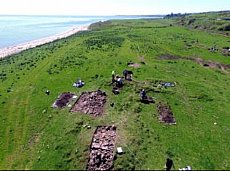Wilkhouse Inn
04 January 2021
- News Type:
- Site of the Month

A variety of inns are known from the Highlands, mainly from documentary evidence. Some were related to troop movements. Some were used by drovers; as cattle were moved only relatively short distances each day, the drovers either camped out or used inns. Later once a good road network was established they were increasingly needed by visitors and tourists.
During investigation of droving routes in east Sutherland, research was undertaken on an old inn north of Brora. The ruinous structures at Wilkhouse, Sutherland (MHG10480; Canmore 75131) were then excavated in a community excavations organised by Clyne Heritage, providing insights into the inn at the beginning of the 19th century. Remains of four separate buildings together with an enclosure thought to be a stance were identified (Adamson and Bailie 2019).
The Roy maps of 1747-1755 shows the buildings next to a routeway. A Sutherland estate map of the 1772 shows the main building to be fairly substantial, corroborated by the excavation results. Telford’s new road, complete by 1819, was re-routed inland, bypassing the inn. 1819 was also a key year, when Kintradwell, including Wilkhouse, was cleared by the Sutherland estate. After Telford’s realignment, the laying of the railway in the 1870 isolated the site further, and on the 1st edition map Wilkhouse is shown as unroofed. Remains of precision surveying instrument may relate to the later 19th century surveys for the railway, but could have been used by estate surveyors.
Fortunately a visit in 1802 by Rev Donald Sage recorded in detail his visit to the inn, remarking on the windows, the floor with sand, the helpful host and the food provided. He stayed overnight however in the manse, not at the inn.
The excavations showed that the inn was built on a site occupied in the Neolithic. The use of the site after this and the date of the building of the inn are still obscure. However, metal detecting during the investigation uncovered 15 coins and a token. The earliest coin dates to 1588, probably lost in the 1590s, and other 17th century coins were also found, but most date to the 18th century.
The two main buildings which co-existed in the 18th and/or early 19th century were of very different construction. The inn was more substantial, with mortared walls and a slate roof, while the other had unmortered walls. Both however had window glass, of a finer type than might have been expected in rural Sutherland. Fittings include a key, clock-winder, remains of an iron cooking pot and some copper fittings.
A number of finds provide an insight into the daily life. There was little bottle glass, suggesting disposal elsewhere. Sherds of drinking glasses of a type from the late 18th/early 19th century were found. Pottery consisted mainly of white earthenware, developed in the 1790s, and red earthenware probably associated with dairying. A range of personal items were uncovered, probably casual losses, including pins, buckles, strap fittings, thimbles and a part of comb. Two military buttons belonging to the Sutherland Fencibles suggest soldiers also used the inn between 1793 and1801.
Environmental analysis suggests the fuel in the fires was a mixture of Scots pine, birch, alder, ash, peat and heather. Despite coal mines at Brora, there is no evidence of coal used as fuel. A range of animal bones including sheep/goat, cattle, pigs and domestic fowl, and mollusc shells were found. Many of the animal bones have evidence of butchery. The sheep bones include both the new improved breeds as well as smaller native breeds. There was also an assemblage of young rabbit bones, as well as some wild birds.
Taken together the excavations provide insight into the inns used at the end of the 18th and beginning of the 19th century. Not a rude hovel, as mentioned by Telford as the state of many inns before his road network, the excavation shows that some at least were substantial buildings, with harled stones, lime mortared walls, glass windows, double chimneys and a slate roof. This suggests enough passing trade to warrant such a building, with the need for a second less well built structure nearby.
The excavation is important in providing physical evidence of one aspect of the travel in the Highlands, probably associated with the droving trade, with evidence of use probably stretching back to the late 16th century.
Further Information
Adamson, Donald and Bailie, Warren 2019 ‘Wilkhouse: An archaeological investigation’, Archaeological Reports Online 37
Highland HER MHG10480
Site of the Month Archive
- 10/04/2021 Easter Raitts township
- 02/03/2021 Lower Slackbuie, Inverness (ASDA) Neolithic site
- 01/02/2021 Balnuaran of Clava cairns
- 04/01/2021 Wilkhouse Inn
- 02/12/2020 Spinningdale Cotton Mill
- 02/11/2020 Skibo A Canadian Forestry Camp
- 01/10/2020 WWI Detonator Store, Dalmore near Invergordon
- 03/09/2020 Mesolithic Shell Midden at Sand, Wester Ross
- 08/08/2020 Kinbeachie Neolithic settlement
- 01/07/2020 Armadale Cist Burial and Stone & Timber Complex
